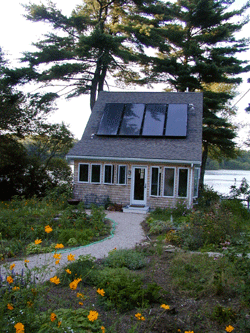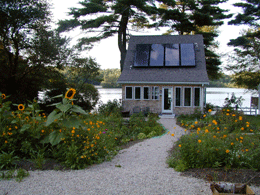Turning Toward the Sun
Air Date: Week of November 11, 2005

Joan Muller's solar heated cottage. (Photo courtesy of Joan Muller.)
The cost of natural gas has more than doubled from last year, prompting many home owners to look for other heating options. Living on Earth's Ashley Ahearn takes a look at how it might benefit homeowners to turn towards the sun.
Transcript
CURWOOD: As the price tag of heating fuel for the oncoming winter months rises, many people are looking at other options. One proposal from Republican Congressman Richard Pombo would let people gather firewood from fallen trees in the National Forests. But there's one source of heat that's been largely left out of the mix. Living on Earth producer Ashley Ahearn takes a look at a new-old way to stay warm during winter: solar heat.
AHEARN: The prospect of paying $1,500 to $2,000 for heat over the coming months is making the phones ring at Clean Energy Design in Osterville, Massachusetts. Tom Wineman, president, says people want to know more about solar heating.
WINEMAN: Used to be once or twice a week, out of the blue, calls. Now it’s twice a day. The curve is starting to go up and up.
AHEARN: Solar heating systems use the sun to directly heat water. Once heated, the water can be used for both bathing and home heating, depending on how it's circulated. Solar panels can be adapted to existing radiators, forced air and radiant heat. The technology hasn't changed much in the past 20 years, and it rarely needs repair. But it's never received as much attention as solar electricity.
WINEMAN: Solar hot water is very under-emphasized, and it’s a very good performer. It just works really well, even in New England. Most people don’t understand that.
AHEARN: But they might be catching on now. Joan Muller called Tom Wineman when she was ready to renovate her home and install solar heating.
[FOOTSTEPS CRUNCHING ON GRAVEL]
AHEARN: It's a little house, only about a thousand square feet. Lots of windows, hardwood floors, an old Siamese cat, and wildflowers in the front yard. The house fits Muller like a glove, and it keeps her just as warm.

Joan Muller's solar heated cottage. (Photo courtesy of Joan Muller.)
AHEARN: The solar panels on Muller's roof heat water, which is then stored in a hot tub-sized tank in her basement and circulated around her home through a radiant floor heating system.
[DOOR CLOSING]
MULLER: Sorry, this is the dingy basement. Watch out, don’t hit your head.
AHEARN: Like most solar heating users, Muller also has a natural gas system in her basement, which she uses to fuel her stove, and as a backup. But now she only uses that backup a few months out of the year. Her solar heating system, while not making her completely independent, is taking a huge chunk out of her natural gas bill.
MULLER: When I’m not heating the house it’s like six or seven dollars, and that’s just for the cooking. In the coldest months I was paying like 60 dollars a month for gas, which I thought, well that’s a lot, because I have solar. But my neighbors were laughing at me cuz their bills were much higher.
AHEARN: Now Muller chuckles a little bit at her neighbors, who might be paying $600 per month during the coldest months of the year.
The biggest problem with solar heat is installation cost. Putting a system in an average three-bedroom home can cost between $15,000 and $20,000. How expensive that is relative to other systems of heating is a constantly shifting picture.
Natural gas prices have more than doubled from last year. That means where it might have taken 12 years for a solar heating system to pay for itself not long ago, payoff time now is closer to five to seven years. Or, if homeowners take out a mortgage to cover that up-front cost, the system can start paying itself off right away.
Rhone Resch is president of the Solar Energy Industry Association.
RESCH: Building the cost of a solar system into a 30 year mortgage will result in a positive cash flow from day one. That is, the amount of money that you are saving on your energy bill will be greater than the increase cost of your mortgage by adding the solar system too.
AHEARN: But the cost is still daunting for many. There's been government support for solar electricity, but state and federal tax breaks for solar heating don't exceed $4,000 combined. The net effect is, if you don't have the cash and can't afford a mortgage or loan, installing solar heat isn't an easy option.
Paul Flemming is with Energy Security Analysis Inc.
FLEMMING: Those who are having a hard time affording their energy for the winter are not going to be able to afford the $15,000 type of number to install a system. The other people at the higher end of the income bracket will be able to afford this price tag, but they're probably somewhat indifferent to the increase in the energy cost. It doesn't hurt them enough to give them incentive to go and do this.
AHEARN: Flemming says that until people start really feeling the pain of heating costs, appearances will continue to be a negative for the solar heating. Many homeowners are reluctant to use the space and change the looks of their homes to make room for a solar set up.
FLEMMING: The guy who can afford it has a nice home. He doesn't want to put a huge solar heating panel on the top of his beautiful colonial home in a nice neighborhood.
AHEARN: But those attitudes may be changing. Numbers are on the rise. Tom Wineman, who installed Joan Muller's system, can't get panels fast enough to meet demand. He says that for people who have the space and the interest, solar heating is an energy solution that's reliable, cost effective and… liberating.
WINEMAN: When people understand these choices they can make, they can be really empowered to realize that they don’t have to get their energy from thousands of miles away. They can choose to at least get a certain portion of it, a good portion of it, right here. And they can be more independent, and not be victimized by the system of energy as it is now. And just, make these choices. There are ones they can make today.
AHEARN: If demand increases, production will ramp up and installation prices will start to go down. Already, with heating costs what they are, the comparative cost of solar heating is looking better than ever before. And that's turning more eyes towards the sun. For Living on Earth, I'm Ashley Ahearn.
Links
State Incentives for Renewable Energy
Living on Earth wants to hear from you!
Living on Earth
62 Calef Highway, Suite 212
Lee, NH 03861
Telephone: 617-287-4121
E-mail: comments@loe.org
Newsletter [Click here]
Donate to Living on Earth!
Living on Earth is an independent media program and relies entirely on contributions from listeners and institutions supporting public service. Please donate now to preserve an independent environmental voice.
NewsletterLiving on Earth offers a weekly delivery of the show's rundown to your mailbox. Sign up for our newsletter today!
 Sailors For The Sea: Be the change you want to sea.
Sailors For The Sea: Be the change you want to sea.
 The Grantham Foundation for the Protection of the Environment: Committed to protecting and improving the health of the global environment.
The Grantham Foundation for the Protection of the Environment: Committed to protecting and improving the health of the global environment.
 Contribute to Living on Earth and receive, as our gift to you, an archival print of one of Mark Seth Lender's extraordinary wildlife photographs. Follow the link to see Mark's current collection of photographs.
Contribute to Living on Earth and receive, as our gift to you, an archival print of one of Mark Seth Lender's extraordinary wildlife photographs. Follow the link to see Mark's current collection of photographs.
 Buy a signed copy of Mark Seth Lender's book Smeagull the Seagull & support Living on Earth
Buy a signed copy of Mark Seth Lender's book Smeagull the Seagull & support Living on Earth

